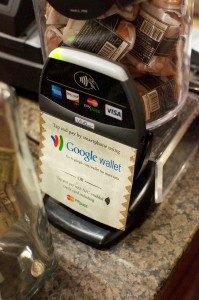Cashless electronic payments are the latest rage. Estimates for smartphone payments using NFC chips is expected to explode, though many estimates are being adjusted. The technology seems to be expected but digital wallet offerings are lacking for sure. AT&T customers still cannot use the default Google Wallet app, and ISIS is in a forever Beta mode. Starbucks seems to have embraced NFC based electronic transactions as well as digital wallet providers Lemon, LevelUp and others. Sprint adopted Google Wallet early on, while Verizon, AT&T and T-Mobile users have been waiting for ISIS to come out of beta in Texas and Utah test beds. The other half of the problem, adoption, is slow as merchants need to invest in new credit card terminals and readers that incorporate the NFC technology to be able to accept these digital payments. As merchants upgrade their terminal technology or Point-Of-Sale systems to bring them up to date, the temptation is there for users. The best reason users do not use an electronic wallet for their transactions? They don’t know they can. They may have a smartphone or tablet with near field communications installed but think their device doesn’t support tap to pay.
One count includes 280 digital wallet providers from cell phone carriers to Starbucks. Many of these competing technologies are incompatible with one another which may be a barrier to entry, but as the better wallet platforms evolve hopefully the playing field will become more level. Japan seems to be leading the world in tap and pay digital wallet transactions. Adoption is wider where traditional payment platforms are less reliable than the United States. In the United States, credit card transactions as well as EBT and Debit Card transactions work reliably and American smartphone users tend not to trust banking information on their devices citing data breaches and hacking as reasoning for the fear. Some merchants are scarcely aware they offer tap to pay as a payment options, often stating ‘wow, how did you do that?’ when a savvy user tries tap to pay as their payment method. More than a conversation starter, many customers witnessing tap and pay at the point of sale are not even aware their phone can handle a NFC transaction until they see someone else doing it. In addition to a smartphone storing credit card and debit card information, many mobile users want the complete digital wallet. This means drivers license, insurance cards and even ticketless travel itineraries. Bus passes and student IDs are big for younger NFC users.
MicroChip Payments, RFID, NFC, and GPS
As the name suggests, Near Field Communication chips also known as NFC, wirelessly communicate locally within a few inches with devices that also include NFC chips is not the only way people are using their digital wallets. Radio Frequency Identification or RFID works on a similar principle but has a greater range. m-commerce (mobile commerce) seems to be moving the way of NFC since the chips are more secure than even traditional credit and debit cards. Chips are coming to the United States as laws have set deadlines on EMV credit cards with both a magnetic stripe and a built in chip, directly embedded in the credit card itself. These allow non smartphone nfc based electronic transactions. Another technology uses barcodes scanned by the customers phone to complete a payment transaction. Still another relies on GPS positioning called geofencing, These transactions take place ‘in the cloud’ as opposed to wirelessly between a smartphone and credit card terminal. There is a competitive advantage to any digital wallet that can service all of the mobile payments in one offering, but that is elusive at best for now.
Offerings, Gift Cards and Loyalty Programs
Another expected aspect to mobile commerce is the loyalty and gift offerings. Retailers love repeat business and now, with the ability to e-mail receipts to customers, the ability to go after the next sale is even better. Reaching out to specific demographics, or enticing a customer to buy accessories or add on items is easier than ever. Loyalty programs offer incentives to potential repeat customers by giving them greater incentives with each visit. With new technologies and user uncertainty how are merchants and digital wallet providers converting users into mobile payments? The answer seems to be enticements. Digital wallet providers are dangling free money for using the wallet for the first time at a new merchant location while merchants are offering special discounts for NFC based transactions while capturing more data about the customer. Privacy experts are pushing for opt in based access to further information beyond the credit card data. They argue the new technology should respect individual privacy.
Though a large rush of mobile electronic payments is eminent, the flood of users has not been as overwhelming as first predicted, though it is on an upward trend. Once certain security and multiple platform support options are in place, digital wallets are expected to be the next big thing in mobile payments.
